After the War: Healing Land and People
By Mara Menahan
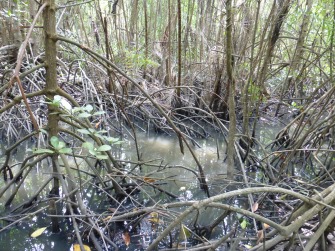 This story is a happy one. It’s a story about local people, regeneration and hope. But first, I want to remind you of a tragic past. In 1961, American troops in Vietnam unleashed the toxic chemical in the sunny skies of the Mekong Delta. The goal of Operation Ranch Hand (the codename for the attack) was to force a mass migration of peasants from their rice paddies and fruit orchards to pro-American cities. With the countryside cleared of people, the Americans prayed that the Viet Cong would be starved of their supporters. Between 1961 and 1971, planes and helicopters dropped a total of 20 million gallons of Agent Orange at a dose 13 times higher than what the U.S. Environmental Protection Agency recommends. The use of the American-made chemical in Vietnam was a warcrime, not just for the cost to human lives, but for the cost to all life. Some call it for what it is–ecocide.
This story is a happy one. It’s a story about local people, regeneration and hope. But first, I want to remind you of a tragic past. In 1961, American troops in Vietnam unleashed the toxic chemical in the sunny skies of the Mekong Delta. The goal of Operation Ranch Hand (the codename for the attack) was to force a mass migration of peasants from their rice paddies and fruit orchards to pro-American cities. With the countryside cleared of people, the Americans prayed that the Viet Cong would be starved of their supporters. Between 1961 and 1971, planes and helicopters dropped a total of 20 million gallons of Agent Orange at a dose 13 times higher than what the U.S. Environmental Protection Agency recommends. The use of the American-made chemical in Vietnam was a warcrime, not just for the cost to human lives, but for the cost to all life. Some call it for what it is–ecocide.
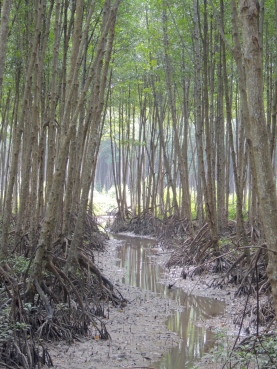 To an American, the destruction of the mangrove forests in the Mekong delta would be like bombing the Redwoods after destroying California’s food-crops. Like the Redwoods, these forests are vital to ecosystem health. If the Redwoods are like lungs, sending sweet oxygen into the air, then mangroves are like kidneys, filtering out toxins and restoring aquatic health. Today, they are even more important since they are helping t
To an American, the destruction of the mangrove forests in the Mekong delta would be like bombing the Redwoods after destroying California’s food-crops. Like the Redwoods, these forests are vital to ecosystem health. If the Redwoods are like lungs, sending sweet oxygen into the air, then mangroves are like kidneys, filtering out toxins and restoring aquatic health. Today, they are even more important since they are helping t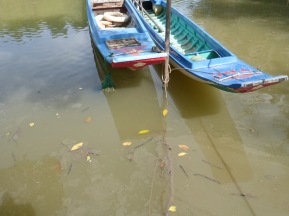 o keep the rising sea at bay, preventing catastrophic flooding and coastal erosion as the climate warms.
o keep the rising sea at bay, preventing catastrophic flooding and coastal erosion as the climate warms.
The only way to experience the mangroves is by boat. Soon after we arrived, we loaded onto a wooden boat with a loud diesel engine. The boat putted down the Long Tau River, passing houses on stilts and shrimp nets. I would never have seen the canal, except that a long narrow boat shot out of the dense foliage. To get a closer look at the mangroves, we needed a smaller boat. We were guided by a shrimp farmer. His boat could only take a few at a time. The first group of students sat cross legged in the bottom of the tiny boat, clinging to the edges white knuckled as the shrimp farmer plunged the motor into the water with a smirk and a wave. As I waited for my turn, watching a kingfisher swoop across the murky water and mudskippers dip into their underground nests, it was hard to believe this area was a no-man’s-land just thirty years ago.
The southern tip of Vietnam is all river. Thick, full silty rivers rimmed with fan palm, coconut trees and mangroves. The nine branches of the Mekong braid across the flat landscape. Swamps, sloughs and canals fill the space in between. Like everything else in the region–the houses, the rice paddies, the markets–the forest also floats. 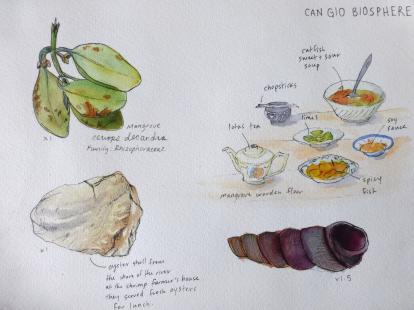 Mangroves adapted to the dynamic waters of coastlines. They specialize in changing salinity and water levels. Their roots thrust deep into the mud, holding up the trunk and the lush branches high above the tides. There are more than forty mangrove species in Vietnam. Interlocking roots trap sediments and without the trees, Vietnam’s coastline would slowly erode.
Mangroves adapted to the dynamic waters of coastlines. They specialize in changing salinity and water levels. Their roots thrust deep into the mud, holding up the trunk and the lush branches high above the tides. There are more than forty mangrove species in Vietnam. Interlocking roots trap sediments and without the trees, Vietnam’s coastline would slowly erode.
When we arrived at a house deep in the Can Gio reserve, I was a little surprised. I’m not used to seeing people living in designated wild places, but here in Vietnam, this is the way conservation gets done. The shrimp farmer lives in a house on stilts, surrounded by water and mangroves on all sides. He uses a small dam to grow shrimp among the mangroves. The 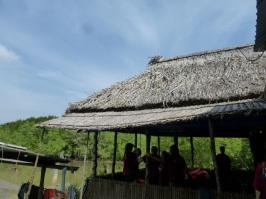 forest provides both food and habitat for the shrimp, and the shrimp acts like fertilizer for the mangroves. Dr. Be explained that this “integrated livelihood system” allows for people to continue to make a living while pursuing conservation goals. Over a meal of catfish, fresh vegetables and rice, we learned that not only is he a shrimp farmer, but he is also a forest guardian. The shrimp farmer earns a bit of income for protecting his part of the mangrove forest from timber harvesters by reporting to local authorities.
forest provides both food and habitat for the shrimp, and the shrimp acts like fertilizer for the mangroves. Dr. Be explained that this “integrated livelihood system” allows for people to continue to make a living while pursuing conservation goals. Over a meal of catfish, fresh vegetables and rice, we learned that not only is he a shrimp farmer, but he is also a forest guardian. The shrimp farmer earns a bit of income for protecting his part of the mangrove forest from timber harvesters by reporting to local authorities.
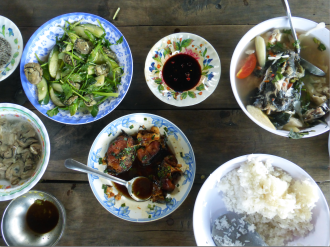 After our meal, we retraced our path down the canal through a tunnel of mangroves, back on the boat and eventually, the bus. We drove a few kilometers further down the road we had taken earlier that day, to a sweeping mudflat. I could see now what the area looked like before the restoration work. We pulled on rubber boots and tromped out into the open field, into the sucking mud, carrying shovels and mangrove seedlings. We passed mangroves that had already been planted, but most of them were less than four feet tall. Our seedlings were about t
After our meal, we retraced our path down the canal through a tunnel of mangroves, back on the boat and eventually, the bus. We drove a few kilometers further down the road we had taken earlier that day, to a sweeping mudflat. I could see now what the area looked like before the restoration work. We pulled on rubber boots and tromped out into the open field, into the sucking mud, carrying shovels and mangrove seedlings. We passed mangroves that had already been planted, but most of them were less than four feet tall. Our seedlings were about t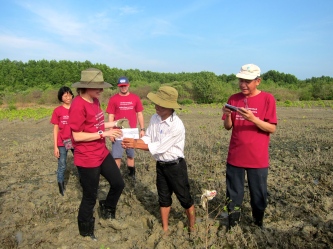 wo feet tall with a single stem and a few clusters of leaves branched on top. We waded our way into the mangrove planting zone. Dr. Be showed us how to squeeze the sapling out of its plastic wrapper at the roots, and dig a five inch hole. I dug my hole with my bare hands, wanting to experience that strange black mud with each one of my senses. After we’d each planted five seedlings, we stood smiling, covered in mud. We shook hands and posed for pictures. Dr. Be awarded us each a certificate. It felt silly, but there really is something ceremonious about restoration work. Healing people, healing land. To me, it felt like some small token of apology for the ecocide my country inflicted. Collectively we planted 65 mangrove trees, a small step in recovering what was lost.
wo feet tall with a single stem and a few clusters of leaves branched on top. We waded our way into the mangrove planting zone. Dr. Be showed us how to squeeze the sapling out of its plastic wrapper at the roots, and dig a five inch hole. I dug my hole with my bare hands, wanting to experience that strange black mud with each one of my senses. After we’d each planted five seedlings, we stood smiling, covered in mud. We shook hands and posed for pictures. Dr. Be awarded us each a certificate. It felt silly, but there really is something ceremonious about restoration work. Healing people, healing land. To me, it felt like some small token of apology for the ecocide my country inflicted. Collectively we planted 65 mangrove trees, a small step in recovering what was lost.

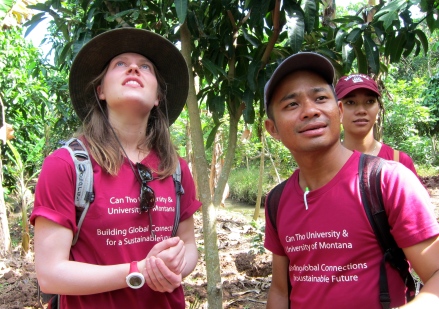
Excellent choice of title, well-connected introduction, efficient recalling of details and meaningful support of pics… Thank your for the report and here are a couple of Vietnam specifics for your extra credits:
. The human cost of war to Vietnam: estimated deaths about 3 millions of the 30 millions population (10%!) and areas of direct Agent Orange spray populated by 10 millions (33%). Additionally, there are over 4 millions overseas Vietnamese through waves of forced or voluntary migrations (5% of the best and brightest).
. The early Vietnamese settlers in the Mekong delta region (1,600’s) adapted to the annual flood by coining the uniquely, southern Vietnamese word “float water season”, not used by anyone else in the country.
Enjoy your trip and have a safe return!
January 16, 2015 at 4:42 am
Dear Hai, you have been a wonderful supporter of our trip and the students. Thank you for your comments. We, too, love the concept of a floating water season, living with nature. We’d love to know a bit more about you, too. More blog posts soon!
January 17, 2015 at 11:46 pm
While there, verify the floating water season in Vietnamese as “mua nuoc noi” with preferably, older people and/or test the younger ones. Meanwhile, I can’t have enough with your blogs and your student’s wonderful perspectives.
January 19, 2015 at 5:31 pm